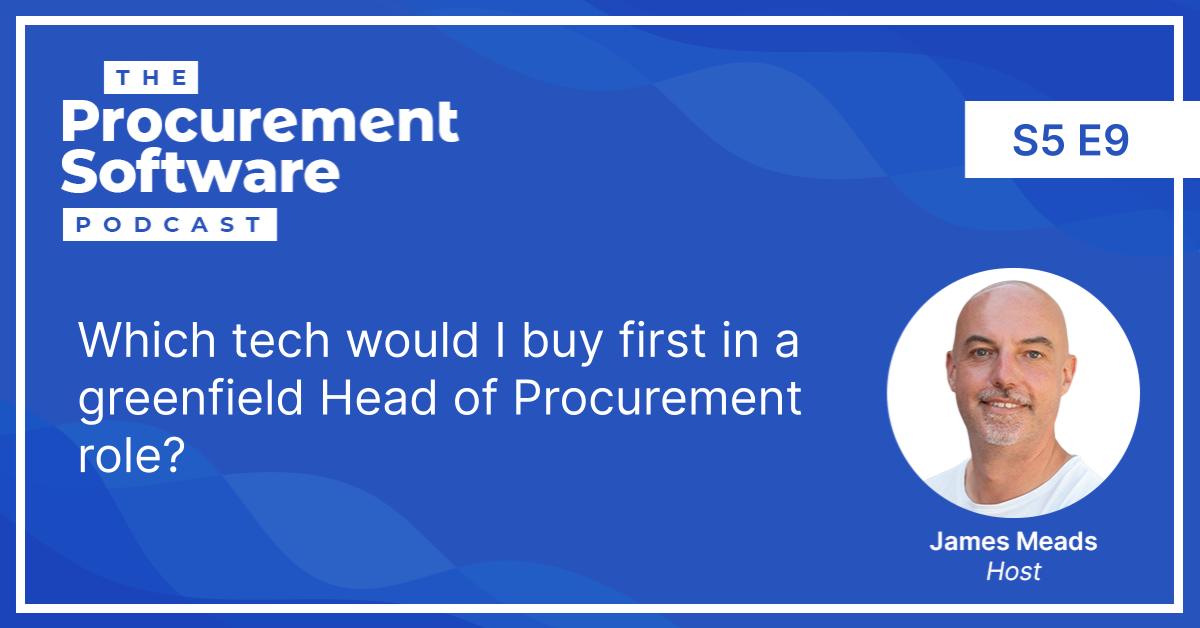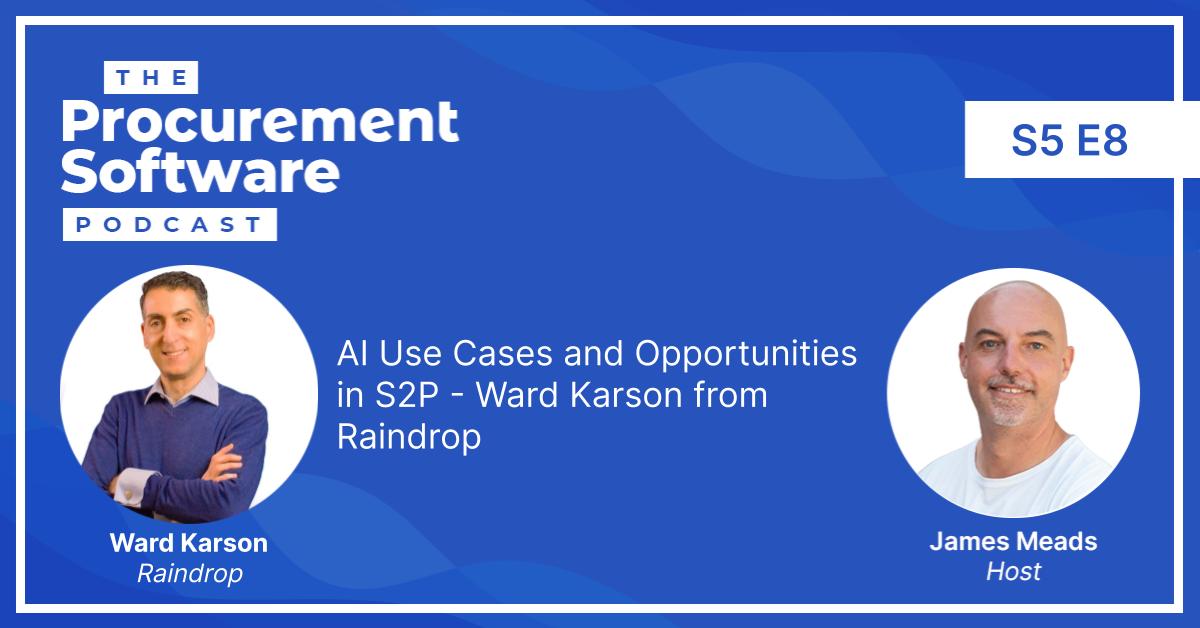On this podcast, I’m proud that we take the time to talk to some of the more early stage companies operating in this space. And you don’t get much more early stage than just launched!
Our guest today is Patrick Jonsson from Digi Procure, whose recently launched company offers a low code / no code guided category strategy creation tool.
I welcome Patrick to the podcast and ask him to open up with a quick intro on his background.
Low code / no solutions in digital procurement
Patrick explains how he doesn’t come from anything of a tech background. From his home in Sweden, he’s embarked on an international career – everywhere from South America to Denmark. The bulk career of this was in procurement for complex organisational setups: Lots of stakeholder management and getting different cultures to agree. Then about three years ago, he went into consulting, but then decided it was time to move into the digital procurement space.
He found low code/no code solutions really interesting, and so following a low budget, bootstrap approach he launched a minimum viable product with his first solution, which only cost around 2000 dollars. There were some issues with his first customers, but in solving those he fell on what seemed to be needed: A solution for guided category strategy creation.
Simplicity is Patrick’s keyword here. Digi Procure is a very simple tool that helps you get started with making category strategies. And with a low code platform, he aims to add further functionality and complexity over time.
I say to Patrick that any SaaS solution will face the conundrum of functional complexity versus user experience. There’s not really a right or wrong answer here, and it can often come down to organisational maturity and complexity. I ask Patrick who he sees as the target users for Digi Procure. Is he aiming for large enterprises, or smaller businesses?
Patrick thinks the answer is medium-sized and up. In his experience, many organisations struggle with making category strategies. You might get a consultant in and end up with a strategy that’s maybe 30-60 pages long, and these just end up on the shelf. Follow up on implementation might not ever get done. Then later you get a new CEO who wants to make some category strategies and you start the whole cycle again.
So Patrick is aiming for what he calls ‘maturity level 2’ companies. By this he means companies who are starting to dabble in strategic sourcing. You need that maturity and you need a certain size – maybe two or three category managers, before it makes sense to use Digi Procure.
Simple and accessible early strategy for medium-sized companies
I say that makes a lot of sense – we’re clearly not looking at greenfield here, as companies that young won’t have anything in place yet. But then the really big companies will probably want to go for that incredibly detailed kind of 60-page plan Patrick mentioned earlier. It’s really the medium-sized businesses that are just starting to dabble in category strategy who have the most to gain here.
Patrick agrees. He goes on to say that you can go more complex, using Digi Procure, and he speaks to some experience with customers who have asked for deeper functionality. But that’s the great thing about low code / no code. It’s adaptable to an individual customer’s needs and particularities in a way that traditional SaaS solutions might struggle with.
There’s also a much lower entry barrier when it comes to price – it doesn’t cost much to experiment with the kind of solution that Patrick is offering, compared to more established platforms with their own internal app stores.
He aims to reach a point where he can use a huge repository of category strategy knowledge, and leverage that to help clients as quickly and responsively as possible.
I bring up another benefit here – category strategy isn’t something that requires an integration with existing ERP systems. It’s an activity that largely allows you to use a standalone piece of technology without having to integrate it into your existing stack.
Patrick says that’s just it – there were a couple of reasons why he chose this area to work in. For one, he is passionate about category strategy, but this ease of integration was definitely a factor too.
The third reason he chose to do this is that he thinks it’s a good place to start, if you want your company to mature. Many organisations struggle to move from operational work to strategic and tactical work. So why not start with simply doing a category strategy, and using a digital format that gets everybody speaking the same language. This lays strong foundations for a company’s journey towards maturity.
Playing devil’s advocate
I play devil’s advocate and pitch a scenario to Patrick. Let’s say I’m a head of procurement at a medium sized business with a team of five or six category managers. The biggest push back I’m going to give you is that strategy management takes too much time, it’s an administrative box-ticking exercise, it’s hard to pull together because everyone’s data is different… Convince me that I’m wrong.
Patrick laughs like someone who’s definitely heard all this before. He sees where this comes from, but this is what he’s trying to attack. As costly as it can be, he thinks that you need strategy or you don’t know where you’re going. Sometimes you need to step back, and yes – that could be a massive workload. But do you need to invest in some hugely elaborate foundation in regard to spend review, or do you simply need to start asking some basic questions like “where do we want to go?”.
He recommends that you should start somewhere, and that’s where a simple tool like Digi Procure can help.
He says that this is where he’s heard great feedback from clients. After even a basic coaching session in strategy they come back to him and say “wow that was really good”.
I ask Patrick how this might work for a high ticket commodity within a mid-market business where the spend is high. Let’s say it’s a critical service or expensive material. How long does it take to put a category strategy through the system, bearing in mind the challenges that mid-sized businesses typically face with bad data.
Patrick says that if you want to go quite simple, his system could do one category in less than an hour. He explains that one of the selling points of his solution is customisation of complexity. You can set the level of detail you want, and that varies the depth of questions that you’ll be prompted with. Then based on your answers, here are some primary and secondary strategies that you might consider. From there you can set goals, barriers, and approvals. So it can be very simple, but it can also get very complicated.
I say that this ability to zoom in and out sounds great, as I used to get frustrated by one-size-fits-all documents back when I used to work in corporate – depending on the category, some things would be totally irrelevant. I like how common sense it is to remove or add levels of detail, so that things remain relevant.
Industry uptake, the complexity sweet-spot, and wrapping up
I ask Patrick where he’s seeing the most interest, from an industry perspective.
He says that it’s early days, and he doesn’t have a lot of customers just yet, but his first customer was in wholesale. Lots of items, buying into warehouses and distributing from there. He now has two other customers – one of them being a global organisation for fast-moving consumer goods, and the other is a machinery production company.
There are some industries he’s not touched yet, such as medicine. But he thinks he’s seeing confirmation that there’s a complexity and maturity sweet-spot where his tool is of most value.
I ask where Patrick sees the ROI with his tool? Is it simply better access to data? Or is it more around driving hard savings and delivering procurement targets?
He says that there’s research out there on category optimization projects and the kind of typical ROI they give. He thinks on average this is around 8.7% per project, but many companies don’t do these projects because they can’t identify where the bang for buck is.
If his tool allows customers to identify which of these projects are worth it, and it can deliver that 8.7% ROI, then it’s definitely worth it.
I agree that this is a pretty meaty chunk, especially as a hedge against some of the price increases that category managers might be facing in direct materials.
As a final question, I put Patrick on the spot by asking him to summarise his tool in one sentence.
He says: Category strategy optimization – get that 8.7%, why would you not do this?
We laugh and conclude that, yes, that sums it up in a nutshell!
I wrap up the podcast by saying that Patrick’s tool is really interesting, particularly to companies who fall into its sweet spot in terms of complexity.
If you’re battling with having a less mature procurement team, but have the desire to put some category strategy data in front of your board, I hope this has caught your interest.
Stay in touch
- Visit ProcurementSoftware.site
- Connect with Patrick Jonsson on LinkedIn
- Visit DigiProcure’s website
- Sign up for the Procurement Software Newsletter
- Book an Intro Call and let’s talk all things Digital Procurement!
- Connect with James on LinkedIn
- Follow Procurement Software’s LinkedIn Page


